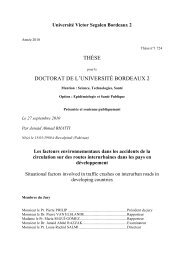Télécharger le texte intégral
Télécharger le texte intégral
Télécharger le texte intégral
Create successful ePaper yourself
Turn your PDF publications into a flip-book with our unique Google optimized e-Paper software.
834 MILLET ET AL.Downloaded By: [EBSCOHost EJS Content Distribution] At: 13:32 29 September 2008Buschke, H., Sliwinski, M. J., Kuslansky, G., & Lipton,R. B. (1997). Diagnosis of early dementia by theDoub<strong>le</strong> Memory Test: Encoding specificity improvesdiagnostic sensitivity and specificity. Neurology, 48,989–997.Car<strong>le</strong>simo, G. A., Mauri, M., Marfia, G. A., Fadda, L.,Turriziani, P., & Caltagirone, C. (1999). Lexical andconceptual components of stem comp<strong>le</strong>tion primingin patients with Alzheimer’s disease. Neuropsychologia,37, 1049–1059.Challis, B. H., Velichkovsky, B. M., & Craik, F I. M.(1996). Levels of processing effects on a variety ofmemory tasks: New findings and theoretical implications.Consciousness and Cognition, 5, 142–164.Clare, L., & Woods, R. (2004). Cognitive training andcognitive rehabilitation for peop<strong>le</strong> with early-stageAlzheimer’s disease: A review. NeuropsychologicalRehabilitation, 14, 385–401.Craik, F. I. M., & Lockart, R. S. (1972). Levels ofprocessing: A framework for memory research.Journal of Verbal Learning and Verbal Behavior,11, 671–684.Dickerson, B. C., Salat, D. H., Greve, D. N., Chua, E.F., Rand-Giovannetti, E., Rentz, D. M., et al. (2005).Increased hippocampal activation in mild cognitiveimpairment compared to normal aging and AD. Neurology,65, 404–411.Fennema-Notestine, C., Butters, N., Heindel, W. C., &Salmon, D. P. (1994). Semantic homophone primingin patients with dementia of the Alzheimer’s type.Neuropsychology, 8, 579–587.F<strong>le</strong>ischman, D. A., & Gabrieli, J. D. E. (1998). Repetitionpriming in normal aging and Alzheimer’s disease:A review of findings and theories. Psychologyand Aging, 13, 88–119.F<strong>le</strong>ischman, D. A., Gabrieli, J. D. E., Reminger, S.,Rinaldi, J., Morrell, F., & Wilson, R. (1995).Conceptual priming in perceptual identificationfor patients with Alzheimer’s disease and a patient withright occipital lobectomy. Neuropsychology, 9, 187–197.F<strong>le</strong>ischman, D. A., Wilson, R. S., Gabrieli, J. D. E., Schneider,J. A., Bienias, J. L., & Bennett, D. A. (2005).Implicit memory in Alzheimer’s disease neuropathology.Brain, 128, 2006–2015.Folstein, M. F., Folstein, S. E., & McHugh, P. R. (1975).Mini-mental state. A practical method for gradingthe cognitive state of patients for the clinician. Journalof Psychiatric Research, 12, 189–198.Fox, N. C., Warrington, E. K., Freeborough, P. A.,Hartikainen, P., Kennedy, A. M., Stevens, J. M., etal. (1996). Presymptomatic hippocampal atrophy inAlzheimer’s disease. A longitudinal MRI study.Brain, 119, 2001–2007.Golby, A., Silverberg, G., Race, E., Gabrieli, S., O’Shea,J., Knierim, K., et al. (2005). Memory encoding inAlzheimer’s disease: An fMRI study of explicit andimplicit memory. Brain, 128, 773–787.Graf, P., & Schacter, D. (1985). Implicit and explicitmemory for new associations in normal and amnesicsubjects. Journal of Experimental Psychology: Learning,Memory and Cognition, 11, 501–518.Greene, J. D. W., Badde<strong>le</strong>y, A. D., & Hodges, J. R.(1996). Analysis of the episodic memory deficit inearly Alzheimer’s disease: Evidence from the doorsand peop<strong>le</strong> test. Neuropsychologia, 34, 537–551.Grober, E., & Buschke, H. (1987). Genuine memory deficitsin dementia. Developmental Neuropsychology, 3, 13–36.Grober, E., Buschke, H., Crystal, H., Bang, S., &Dresner, R. (1988). Screening for dementia by memorytesting. Neurology, 38, 900–903.Grober, E., & Kawas, C. (1997). Learning and retentionin preclinical and early Alzheimer’s disease. Psychologyand Aging, 12, 183–188.Grober, E., Lipton, R. B., Hall, C., & Crystal, H.(2000). Memory impairment on free and cued se<strong>le</strong>ctivereminding predicts dementia. Neurology, 54,827–832.Haw<strong>le</strong>y, K. J., & Johnston, W. A. (1991). Long-termperceptual memory for briefly exposed words as afunction of awareness and attention. Journal ofExperimental Psychology. Human Perception and Performance,17, 807–815.Heindel, W. C., Cahn, D. A., & Salmon, D. P. (1997).Non-associative <strong>le</strong>xical priming is impaired in Alzheimer’sdisease. Neuropsychologia, 35, 1365–1372.Heindel, W. C., Salmon, D. P., Fennema-Notestine, C.,& Chan, A. S. (1998). Repetition priming with nonverbalstimuli in patients with dementia of theAlzheimer type. Neuropsychology, 12, 43–51.Jones, S., Livner, A., & Bäckman, L. (2006). Patterns ofprospective and retrospective memory impairment inpreclinical Alzheimer’s disease. Neuropsychology, 20,144–152.Keane, M. M., Gabrieli, J. D. E., Fennema, A. C.,Growdon, J. H., & Corkin, S. (1991). Evidence for adissociation between perceptual and conceptualpriming in Alzheimer’s disease. Behavioral Neuroscience,105, 326–342.Keane, M. M., Gabrieli, J. D., Growdon, J. H., &Corkin, S. (1994). Priming in perceptual identificationof pseudowords is normal in Alzheimer’s disease.Neuropsychologia, 32, 343–356.Koivisto, M., Portin, R., & Rinne, J. O. (1996). Perceptualpriming in Alzheimer’s and Parkinson’s diseases.Neuropsychologia, 34, 449–457.McKahn, G., Drachman, D., Folstein, M., Katzman, R.,Price, D., & Stadlan, E. M. (1984). Clinical diagnosisof Alzheimer’s disease: Report of the NINCDS-ADRDA work group under the auspices of Departmentof Health and Human Services Task Force onAlzheimer’s disease. Neurology, 34, 939–944.Meiran, N., & Jelicic, M. (1995). Implicit memory inAlzheimer’s disease: A meta-analysis. Neuropsychology,9, 291–303.Mitchell, D. B., & Schmitt, F. A. (2006). Short- andlong-term implicit memory in aging and Alzheimer’sdisease. Neuropsychology, Development and Cognition:Section B, Aging, Neuropsychology and Cognition,13, 611–635.Mochizuki-Kawai, H., Mochizuki, S., Midorikawa, A.,Yamanaka, K., Tagaya, H., & Kawamura, M.(2006). Disappearance of memory fragments inpatients with Alzheimer’s disease: Evidence from alongitudinal study of visual priming. Neuropsychologia,44, 1114–1119.Ostergaard, A. L. (1994). Dissociations between wordpriming effects in normal subjects and patients withmemory disorders: Multip<strong>le</strong> memory systems orretrieval? The Quarterly Journal of Experimental Psychology,47, 331–364.Pasquier, F., Grymonprez, L., Lebert, F., & Van derLinden, M. (2001). Memory impairment differs infrontotemporal dementia and Alzheimer’s disease.Neurocase, 7, 161–171.
















